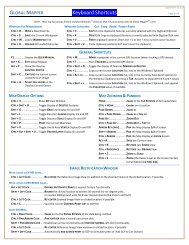Map GPS Coordinates - GPS Map Coordinates ... - Global Mapper
Map GPS Coordinates - GPS Map Coordinates ... - Global Mapper
Map GPS Coordinates - GPS Map Coordinates ... - Global Mapper
You also want an ePaper? Increase the reach of your titles
YUMPU automatically turns print PDFs into web optimized ePapers that Google loves.
utton while moving the mouse will disable this functionality and allow you to click all the way to the edge of<br />
the Zoomed View.<br />
To select a location for control point entry, position the crosshair over the pixel of interest, then press and<br />
release the left mouse button. This will cause the pixel coordinates of the point to be entered in the Ground<br />
Control Point (GCP) Entry portion of the dialog (described below). In addition, a small red dot will be placed<br />
at the click location to make it easy to see. If you also hold down the CTRL key when clicking the left mouse<br />
button, the Reference Image view will be recentered on the associated point and the reference coordinates wil<br />
automatically be filled in if there have been enough control points entered to convert the coordinates. If you<br />
hold down the SHIFT key when left-clicking, the current control point will automatically be added to the GCP<br />
list, just as if you had pressed the Add GCP to List button.<br />
Reference Images<br />
The Reference Images portion of the Image Rectifier dialog allows the user to view what is currently loaded<br />
in the main <strong>Global</strong> <strong>Map</strong>per view and to enter ground coordinates by left-clicking on an appropriate place on<br />
the view. This can be very useful for doing things such as rectifying a satellite photo by clicking on the<br />
Zoomed View at a road intersection to select the pixel coordinates, then clicking on the intersection of those<br />
roads on a vector file loaded into the main view. By default when you click near a vector feature in the<br />
Zoomed View, the location will snap to that vector feature. You can disable this behavior by holding down the<br />
ALT key when clicking. If you hold down the SHIFT key when clicking, the clicked coordinates will be<br />
rounded to the nearest 30 seconds for arc degree units and the nearest 1000 ground units for other coordinate<br />
units. Holding down the CTRL key when clicking the left mouse button will cause the Zoomed Image view<br />
will be recentered on the associated point and also fill in the pixel X and Y coordinatess automatically if there<br />
have been enough control points entered to convert the coordinates.<br />
You can also zoom and pan the Reference Images view in a manner identical to the Zoomed Images view.<br />
Ground Control Point (GCP) Entry<br />
This portion of the dialog is where you actually enter the ground control points (GCPs) that define where the<br />
image is on the earth. Typically, you will click a position in the zoomed view to fill in the pixel coordinates,<br />
then manually enter the ground coordinates into the X/Easting/Lon and Y/Northing/Lat data fields or else<br />
select a point from the Reference Image view for the ground coordinates.<br />
IMPORTANT: If you manually enter the ground coordinates, you must enter them in the coordinate system<br />
indicated by the Ground Control Point Projection portion of the dialog, otherwise you will get incorrect<br />
results. The one exception is that if you enter a value that looks like a lat/lon coordinates but a projected<br />
system is selected, you will be prompted to select whether or not the entered coordinates are lat/lon<br />
coordinates or coordinates in the selected projection system.<br />
Once the coordinates are entered, press the Add GCP to List button to add the GCP to the list of GCPs to be<br />
used when rectifying the image. The Update Selected GCP button allows you to update the coordinates<br />
associated with a previously entered GCP. You can also use Alt+R to simulate pressing the Update Selected<br />
GCP button.<br />
Ground Control Point (GCP) Projection<br />
<strong>Global</strong> <strong>Map</strong>per User's Manual<br />
This portion of the dialog allows you to select the projection that ground coordinates are entered in as well as<br />
what projection the image will be natively treated as when rectified (it can be reprojected later using the<br />
normal <strong>Global</strong> <strong>Map</strong>per reprojection mechanisms). See the IMPORTANT note above for more details.<br />
<strong>Map</strong> <strong>GPS</strong> <strong>Coordinates</strong> - <strong>GPS</strong> <strong>Map</strong> <strong>Coordinates</strong> - <strong>GPS</strong><strong>Coordinates</strong> <strong>Map</strong> 107







